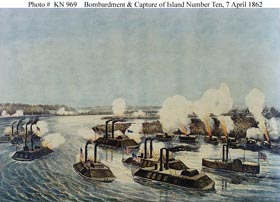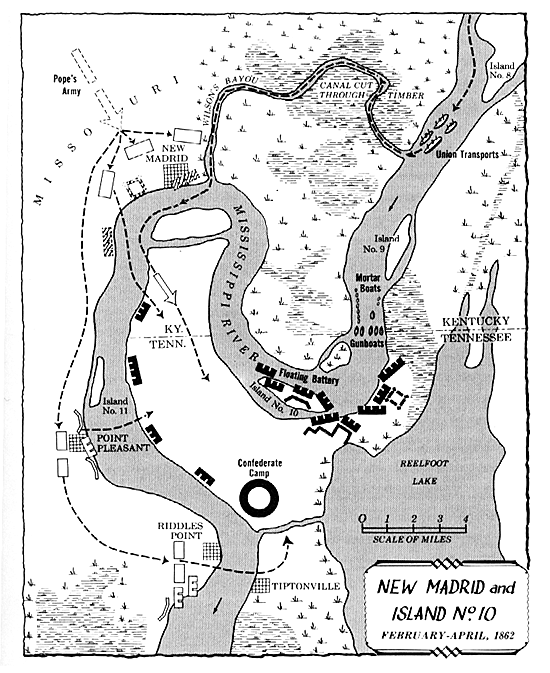Civil War Battles |
Colonial Wars |
American Wars |
Link To This Page — Contact Us —
The Battle of Island No. 10
April 7, 1862 in Island No. 10, Missouri
 |
|||||||||||||||||||
|
About 60 miles below Columbus, Kentucky, Confederates fortified bluffs overlooking the Mississippi River and constructed batteries on the eastern side of an island there, Island No.10. At New Madrid, Missouri, about 10 miles downriver, a few Confederate guns and boats protected the western approaches to the elomgated peninsula area called New Madrid Bend. Created by the river, this neck of land provided ready communications with Confederate defenses along the crescent-shaped bend in the river where the island lay. Together, these defenses, manned by 7,000 Confederates, barred passage to Union troops and boats.
On the same day that Pope discovered the evacuation of New Madrid, Flag Officer Andrew H. Foote left Cairo, Illinois bound for Island No. 10. The impressive flotilla included 7 ironclad gunboats, among them the massive Benton, and 10 mortar rafts, each mounting one 13-inch seacoast mortar, 95 heavy guns in all. After a brief stop at Bird's Point, Missouri to pick up Col. Napoleon Buford's Brigade of infantry to support the fleet, the flotilla arrived above the island in the early morning hours of March 15th. Foote immediately began a bombardment of the island and the surrounding batteries, a bombardment that lasted 22 days, but it had little effect.
Maj. Gen. John Pope quickly began urging Foote to run his fleet past the batteries and join him at New Madrid, where they could cut off the Confederate force by hemming it in on the Tennessee Peninsula. Foote, overly cautious and suffering from a wound received at Fort Donelson, rejected Pope's plan, believing that it would certainly allow the destruction of the fleet. Instead he actively engaged the Confederates only once, leaving most of the bombardment to the mortar rafts.
The one engagement was a rather heated duel between 3 of the gunboats and the Redan Fort on the Tennessee shore. Foote ordered the Benton lashed between 2 of the ironclads, a precaution in case one of the boats became disabled so it would not float downstream into Confederate hands. The 3 ironclads attacked the Redan bows forward, the mortars and the rest of the fleet joining in as their guns would allow, distance being the determining factor. The Redan, commanded by Capt. Edward W. Rucker, was armed with three 8-inch columbiads and three 32-pounders (smoothbore) and was partially flooded. The 32 pounders were not used during the 3-hour fight, unable to reach out far enough, but the huge Lady Polk, Jr., a 128-pounder on the island did join in from 3 miles away along with a rifled 32 in another shore battery. The Benton took 3 direct hits and the ironclad St Louis was struck several times. The Redan took a tremendous pounding, but the cannoneers stuck with the guns throughout the engagement and eventually Foote retired. Trudeau was elated with his troops performance, and Rucker proclaimed a hero in the Memphis papers; good news from Tennessee was badly needed and repulsing the ironclads qualified.
The March 17th attack marked the end of Foote's offensive efforts with the gunboats, for the next few weeks most of the fleet sat idle, the Confederates called the fleet "humbug" and the Northern Press gang, which was in full force with the fleet, was not much kinder. Pope grew increasingly impatient, telegraphing Foote daily to make a move. Finally in desperation, Pope ordered a canal cut across the Missouri peninsula. Col. J.W. Bissell and the Engineering Regiment of the West were put to work on March 23rd and finished the effort on April 2nd. "Canal" is somewhat of a misnomer, since the area was flooded. The major part of the work was cutting a path through the bayous, which Bissell's engineers accomplished by devising an ingenious method of cutting trees below the water line. By the time the canal was completed the river had dropped and only four small transports were able to get through to New Madrid, the ironclads draft being too great.
Soon after the arrival of the Federal Fleet General McCown began asking his commander, Gen. P. G. T. Beauregard for reinforcements. Beauregard declined; his attention was focused on the Tennessee River and a different object at Pittsburg Landing. Beauregard did suggest that General Earl Van Dorn could relieve the besieged garrison by attacking Pope from the rear. This was impossible since Van Dorn's troops were still reeling from their defeat at Pea Ridge. At this point the Creole General's plans for the river become a little schizophrenic. His overall strategy was to build smaller garrisons, and then relieve them when they came under attack. This option was not available at Island No. 10 because of the concentration taking place in Southwestern Tennessee.
Finally, Beauregard issued a circular outlining his new plan for defense of the river, which in essence a directive on the order of retreat. McCown moved 6 of his regiments, two artillery companies and most of his cavalry down from Madrid Bend to Fort Pillow, for transfer over to Beauregard's army. This left about 4,000 men present for duty in the entire Madrid Bend area of operations, 400 of which were unarmed. On the 31st, Beauregard, apparently believing that the position could still be held until it was relieved or at least successfully evacuated, replaced McCown with Maryland native Brig. Gen. William W. MacKall. MacKall was part of Beauregard's anti-Davis clique. A West Pointer and former Lt. Col. in the Regular Army, he had served as Assistant Adjutant General of the Department of the Pacific.
MacKall arrived at Madrid Bend and found his new command disheartened, poorly armed and the Confederate gunboats in the vicinity useless. Just before his arrival the Flotilla Brigade under Buford had surprised and routed Col. Ed Pickett's Confederate garrison at Union City, Tennessee and severed one important line of communication. To add to those woes, on April 1st a forty man squad from the flotilla stole down river in skiffs, surprised the sentries at the Redan and spiked the guns. Mackall's best ally was Foote's inaction, but Pope was pressing from every angle.
At last the major part of Pope's army, which now numbered nearly 25,000 had arrived on the Tennessee shore. MacKall's force headed south for Tiptonville with Pope's pursuing army in his rear. A few brief rear guard actions were attempted, but the Confederates would not stand their ground. Outnumbered and outgunned, MacKall's force stopped on the western outskirts of Tiptonville the evening of the 7th. The trap was set. Col. James D. Morgan's Brigade marched past Tiptonville on the river (east) side and occupied the South end of town and Col. Gilbert W. Cumming's Brigade moved in on MacKall from the North. MacKall had nowhere to go with Reelfoot Lake to his west. At 2:00 A.M. he sent word to the Federals of his surrender.
As for the island itself, early on the 7th word reached it's acting commander Capt. Andrew Jackson, Jr. that Pope had crossed the river. The Confederates quickly set to work trying to plug the river by sinking 8 steamers in the channel. By late afternoon, many of the heavy artillery companies, together with some of the remaining infantry began crossing Reelfoot Lake by any means available. The island was formally surrendered to Foote at 3:45 A.M. on the morning of the 8th.
Pope reported to Halleck that he had captured 7,076 men, along with all arms and artillery. In reality it was closer to 4,000. On the Confederate side, some measure of success has to be considered too. After all, 4000 men kept the Army of the Mississippi at bay for 5 weeks at a time when numbers were critical in the west.
In the final analysis, it was the 1-2 punch of combined operations that made the Union Mississippi River campaign so successful. The Confederates never were able to develop a counter strategy. When Island No. 10 fell, the Mississippi River was open all the way to Vicksburg for all practical purposes.

